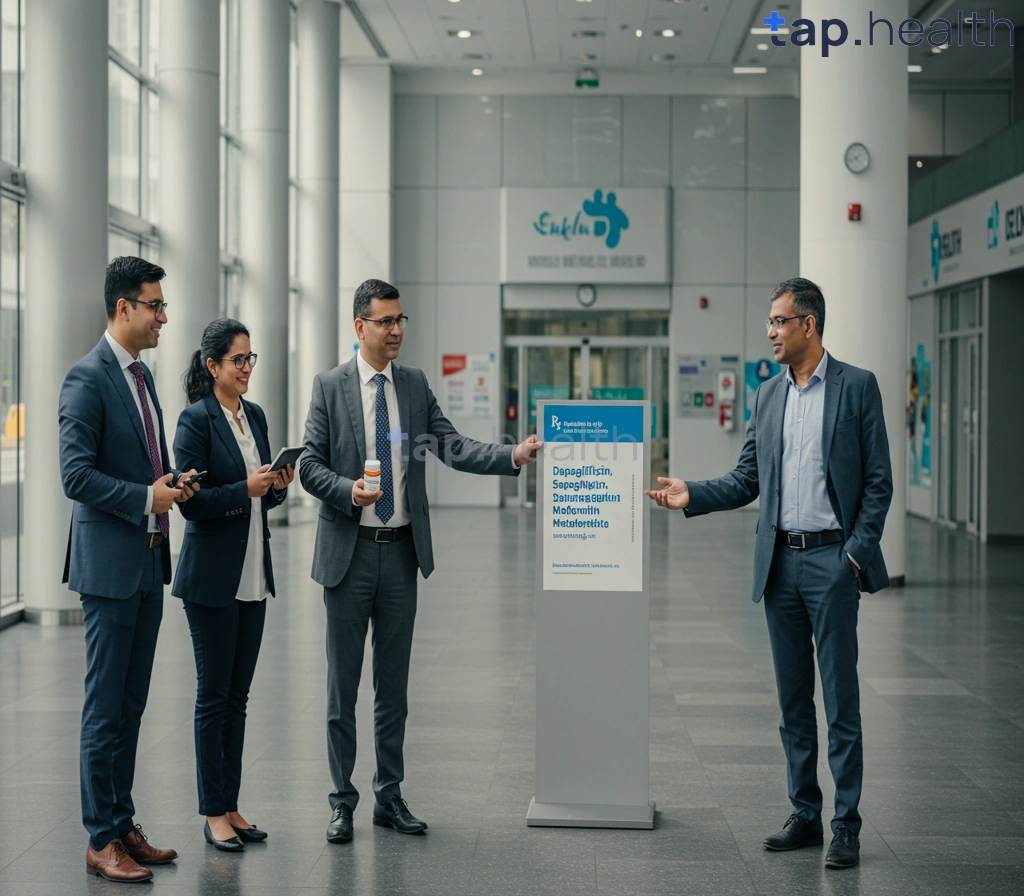Type 2 diabetes is a growing health concern, particularly in regions like India and other tropical countries where lifestyle and environmental factors play a significant role. Oral medications like Dapagliflozin, Saxagliptin, and Metformin are commonly prescribed to control blood sugar levels effectively. This guide explores how these drugs work individually and together, their benefits, potential side effects, and practical tips for managing diabetes in tropical climates. With a focus on clarity and actionable insights, this blog answers common questions about these medications in a concise question-answer format, tailored to help you take control of your diabetes management.
How Do Dapagliflozin, Saxagliptin, and Metformin Work Together?
What is the combined effect of these medications? Dapagliflozin, Saxagliptin, and Metformin work synergistically to manage type 2 diabetes by targeting different aspects of blood sugar control. Metformin reduces glucose production in the liver and improves insulin sensitivity. Dapagliflozin, an SGLT2 inhibitor, promotes glucose excretion through urine. Saxagliptin, a DPP-4 inhibitor, enhances insulin production and reduces glucagon levels. Together, they provide a comprehensive approach, often more effective than metformin alone, especially for those struggling to meet blood sugar targets.
Why is this combination effective? The trio addresses multiple pathways of glucose regulation, offering better control than a single drug. This is particularly helpful for patients in India and tropical regions, where diet and climate can complicate diabetes management. Regular monitoring and doctor consultations ensure optimal results.
What Are the Individual Roles of These Diabetes Drugs?
How does Metformin help with type 2 diabetes? Metformin, a biguanide, is often the first-line treatment for type 2 diabetes. It reduces liver glucose production and enhances insulin sensitivity in muscles, making it effective and affordable. Its long-standing safety profile makes it a cornerstone of diabetes care globally, including in tropical regions.
What is Dapagliflozin’s role in diabetes management? Dapagliflozin, an SGLT2 inhibitor, lowers blood sugar by increasing glucose excretion through urine. It also offers benefits like weight loss and reduced cardiovascular risks, making it ideal for patients with additional health concerns like heart or kidney issues.
How does Saxagliptin contribute to blood sugar control? Saxagliptin, a DPP-4 inhibitor, boosts the body’s natural insulin production after meals and reduces glucagon levels, which helps prevent blood sugar spikes. It’s often used in combination therapy when metformin alone isn’t enough.
Which Diabetes Drug Is Right for You?
How do you choose between Dapagliflozin, Saxagliptin, and Metformin? The choice depends on individual factors like blood sugar levels, kidney function, heart health, and lifestyle. Metformin is typically the starting point due to its efficacy and cost. Dapagliflozin suits those needing additional cardiovascular or kidney benefits. Saxagliptin is ideal for enhancing insulin production without significant side effects. Your doctor will assess your health profile to recommend the best option or combination.
What factors influence the decision? Considerations include co-existing conditions (e.g., kidney disease), medication interactions, and lifestyle factors like diet (aim for 45–60 grams of carbs per meal, adjusted to your needs). In tropical climates, hydration and regular blood sugar monitoring are critical to counter environmental effects.
How to Manage Type 2 Diabetes Effectively with Oral Medications
What makes these medications effective for type 2 diabetes? Dapagliflozin, Saxagliptin, and Metformin target different mechanisms of blood sugar regulation, offering a robust solution. Their combined use can delay or prevent complications, with up to 80% of type 2 diabetes cases manageable through medication and lifestyle changes.
What lifestyle changes complement these medications? In tropical regions, incorporate locally available, low-glycemic foods like whole grains, vegetables, and fruits. Stay hydrated to counter heat-related dehydration, which can affect blood sugar. Aim for 150 minutes of moderate exercise weekly, adjusted for climate conditions. Regular check-ups for blood pressure, cholesterol, and dental health are also essential.
What Are the Benefits and Risks of This Combination Therapy?
What are the benefits of using Dapagliflozin, Saxagliptin, and Metformin together? This combination provides superior blood sugar control by addressing multiple pathways. It can reduce the risk of complications like heart disease and kidney issues, particularly with Dapagliflozin’s added benefits. It’s especially effective for patients not responding to metformin alone.
What are the potential risks or side effects? Side effects vary by individual. Metformin may cause gastrointestinal issues, Dapagliflozin can increase urinary tract infection risk, and Saxagliptin may lead to mild headaches or joint pain. Regular monitoring and doctor consultations help manage risks. Discuss other medications (e.g., Lexapro) to avoid interactions.
How to Start and What to Expect from This Treatment
How do you begin treatment with these medications? Start under a doctor’s guidance. They’ll assess your health, prescribe appropriate dosages, and monitor progress through regular blood sugar checks. Expect adjustments based on your response and lifestyle factors, especially in tropical climates where diet and heat play a role.
What should you expect during treatment? You’ll likely see improved blood sugar levels with consistent use. Lifestyle changes, like a balanced diet and exercise, enhance outcomes. Regular check-ups ensure the treatment remains effective and safe. Discuss any side effects or concerns promptly with your doctor.
Practical Tips for Diabetes Management in Tropical Climates
How does climate affect diabetes management? In hot, humid regions like India, dehydration and heat can spike blood sugar levels. Stay hydrated, monitor glucose regularly, and adapt exercise routines to cooler times of the day. Incorporate local foods with blood sugar-regulating properties, like bitter gourd or fenugreek.
What are actionable steps for better outcomes?
- Monitor blood sugar daily and track results.
- Adhere to prescribed medication schedules.
- Follow a balanced diet with controlled carb intake (45–60 grams per meal).
- Exercise regularly, aiming for 150 minutes of moderate activity weekly.
- Join support groups for motivation and education.
- Schedule regular health check-ups, including dental visits, to prevent complications.
Frequently Asked Questions About Dapagliflozin, Saxagliptin, and Metformin
Q1: Why combine these three medications? They target different aspects of blood sugar control, offering better results than metformin alone, especially for complex cases.
Q2: Are there specific considerations for tropical regions? Yes, heat and diet can affect diabetes. Stay hydrated, monitor glucose levels, and incorporate local, low-glycemic foods.
Q3: Can these drugs cause side effects? Yes, possible side effects include gastrointestinal issues (Metformin), urinary infections (Dapagliflozin), or headaches (Saxagliptin). Consult your doctor to manage them.
Q4: How do I know if this treatment is right for me? Your doctor will evaluate your health, lifestyle, and blood sugar levels to tailor a plan. Regular follow-ups ensure effectiveness.
Conclusion
Managing type 2 diabetes with Dapagliflozin, Saxagliptin, and Metformin offers a powerful, multi-faceted approach to blood sugar control. By understanding how these medications work, their benefits, and potential risks, you can make informed decisions with your doctor. In tropical climates like India, combining these drugs with lifestyle changes—such as a balanced diet, regular exercise, and hydration—can significantly improve outcomes. Take proactive steps today by consulting a healthcare professional to create a personalized diabetes management plan. With the right tools and support, you can live a healthier, more fulfilling life despite diabetes.



